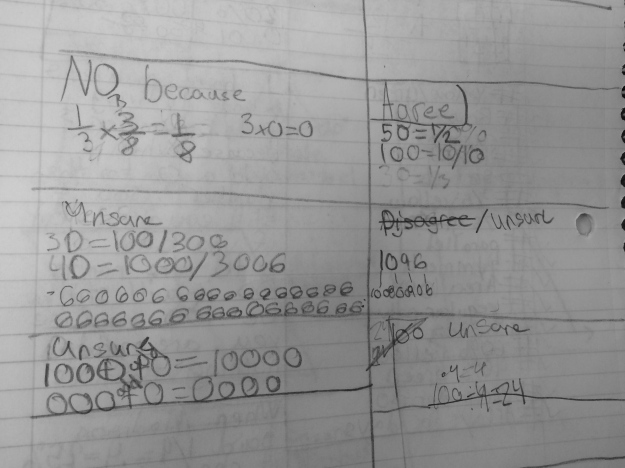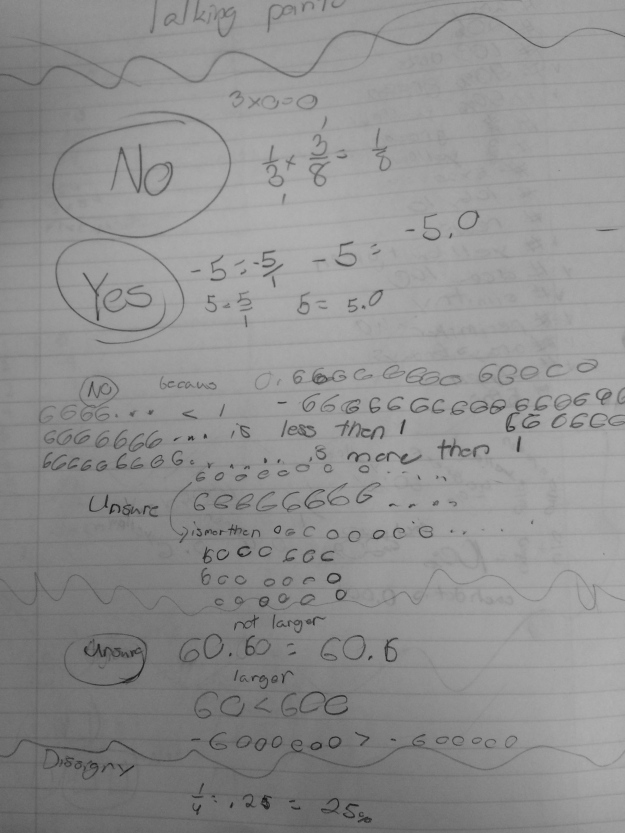This week, we are beginning our decimal unit. I decided to start with Talking Points today to hear how the students are thinking about decimals before we dig in. In developing the Talking Points, I asked the #mtbos for some ideas on decimal misconceptions/misunderstandings they see students have each year. Thanks to @MikeFlynn55, @AM_MathCoach, and @MsJWiright2 for your thoughts! Of course as the students were talking today, I wanted to tweak my wording of the statements! Here are the points I used, my intended purpose of the statement, what I noticed and possible rewording for future use…
 TP1 – My goal in this statement was to hear if students were thinking about multiplying by a number (fraction or decimal) less than one. The first thing I realized is that I have a class obsessed with negative numbers! Then the next thing that other groups talked about a lot was multiplying by zero or 1. I did have some students think about fractions, like in the example below. In future wording, I would probably adjust it to, ” When multiplying by a number other than 0 or 1, the product is greater than the factors.”
TP1 – My goal in this statement was to hear if students were thinking about multiplying by a number (fraction or decimal) less than one. The first thing I realized is that I have a class obsessed with negative numbers! Then the next thing that other groups talked about a lot was multiplying by zero or 1. I did have some students think about fractions, like in the example below. In future wording, I would probably adjust it to, ” When multiplying by a number other than 0 or 1, the product is greater than the factors.”
 TP2: My goal with this statement was to hear if students thought about taking any number and make equivalents. My initial thought was just fraction/decimal equivalents like .3 = 3/10, but I did run into some great conversations about 3=6/2=3.0. The problem was that some were agreeing because they were just taking any number and writing it a fraction, not equivalent, just plopping it into a random fraction, like 7 can be 1/7 can be .7 can by 7/8, as long as there was a 7! Possible rewording would be “All numbers can be written as equivalent fraction and decimals.”
TP2: My goal with this statement was to hear if students thought about taking any number and make equivalents. My initial thought was just fraction/decimal equivalents like .3 = 3/10, but I did run into some great conversations about 3=6/2=3.0. The problem was that some were agreeing because they were just taking any number and writing it a fraction, not equivalent, just plopping it into a random fraction, like 7 can be 1/7 can be .7 can by 7/8, as long as there was a 7! Possible rewording would be “All numbers can be written as equivalent fraction and decimals.”
 TP3: This one was to elicit conversation about a comparison problem in which I see students often having a misconception. In comparing, students will think that 0.35 is less than 0.1245 because it has more digits. This one blew up in my face, of course:) The negative numbers arose again, which was interesting however, the some very clever students wrote 00000001 and said it is smaller than 12, but it has more digits. They were right, my statement was bad. Possible rewording, “The more digits a number has after the decimal point, the larger the number is.”
TP3: This one was to elicit conversation about a comparison problem in which I see students often having a misconception. In comparing, students will think that 0.35 is less than 0.1245 because it has more digits. This one blew up in my face, of course:) The negative numbers arose again, which was interesting however, the some very clever students wrote 00000001 and said it is smaller than 12, but it has more digits. They were right, my statement was bad. Possible rewording, “The more digits a number has after the decimal point, the larger the number is.”
TP4: This one was really to plant a seed for the unit. I wanted students thinking about the place of the digit and its relationship to the digits surrounding it. So often when we decompose numbers, we deal with place values independently but I want to really focus on how the value changes as we move within the number. This one elicited great points made by the students and I plan on revisiting this one often throughout the course of our work together. This is one student’s reflection afterwards about this point:
 TP5: My goal was to see if students thought about equivalency between decimals such as .3 and .30. The talk at each table was interesting and it was definitely one that was a split decision at many tables. I would leave this prompt the same based on the student responses, it was a nice mix and the mention of decimals came out vaguely. Student reflection on how another student changed his thinking:
TP5: My goal was to see if students thought about equivalency between decimals such as .3 and .30. The talk at each table was interesting and it was definitely one that was a split decision at many tables. I would leave this prompt the same based on the student responses, it was a nice mix and the mention of decimals came out vaguely. Student reflection on how another student changed his thinking:
 TP6: I used this point to check for equivalency understanding of fractions and percents (because we have worked with them) and then to see any connections to decimals. A lot times, student will take the fraction denominator and put that right behind the decimal point to make equivalents. This one was eh. I like that students knew 1/4 = 25% so the conversation focused on the meaning of the decimal in relation to the other two. I may reword this to, “.4 = 4%” and leave it at that.
TP6: I used this point to check for equivalency understanding of fractions and percents (because we have worked with them) and then to see any connections to decimals. A lot times, student will take the fraction denominator and put that right behind the decimal point to make equivalents. This one was eh. I like that students knew 1/4 = 25% so the conversation focused on the meaning of the decimal in relation to the other two. I may reword this to, “.4 = 4%” and leave it at that.
After the points, I had the students reflect on two prompts…
“I am still having doubts about Talking Point __- because….” and “When (insert person’s name) said ___________ it changed my mind about Talking Point ___ because…” Some samples of these are above and here are a few more….




I really like the idea of the Talking Points and having students discuss whether they agree or disagree with the statements. The reflection piece for the students is great!
Thanks for taking the time and reflecting on each statement and how you would change it for the future.
LikeLike
Pingback: Decimals – The Very Beginning… | Math Minds
Pingback: #IntentTalk Chapter 1 | Math Minds
Pingback: Fraction Talking Points: 3rd Grade | Math Minds